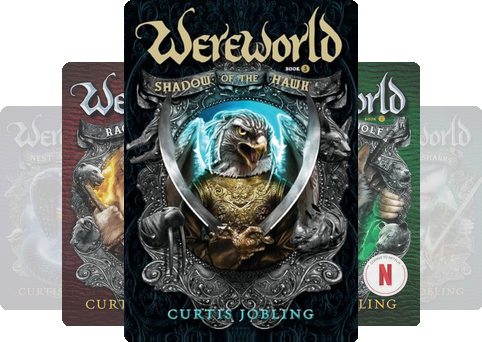Introduction to the World of Lyssia
The Wereworld series transports readers to the Seven Realms of Lyssia, a medieval-inspired fantasy world where the nobility consists of werelords – humans who can transform into powerful animal forms. Unlike typical werewolf stories, this series features an entire hierarchy of shapeshifters, each representing different animal species with unique abilities and political influence. At the heart of this world is Drew Ferran, an unassuming shepherd boy who discovers his true heritage as both a werewolf (the rarest and most feared of the werelords) and the rightful heir to the throne of Lyssia. His coming-of-age story forms the backbone of this six-book saga that combines elements of high fantasy, political intrigue, and brutal warfare.
Detailed Book-by-Book Breakdown
1. Rise of the Wolf (2011)
The inaugural book introduces readers to Drew’s transformation into a werewolf and his subsequent quest to understand his identity amidst a kingdom rife with danger and deception. The series opener introduces Drew Ferran, living a simple life in the rural province of Cold Coast. When he unexpectedly transforms during a traumatic event, his world is upended. Key elements include:
- Drew’s first terrifying transformation and subsequent exile
- Introduction to the werelord political system
- First encounters with Duke Bergan the Werebear
- Revelation about Drew’s royal lineage
- Early clashes with King Leopold’s forces
2. Rage of Lions (2011)
As Drew grapples with his newfound powers, he confronts formidable adversaries and uncovers deeper conspiracies that threaten the stability of Lyssia. The second installment sees Drew coming to terms with his identity while the political landscape becomes increasingly dangerous. This book features:
- Introduction of key allies: Hector the Wereboar and Gretchen the Wererat
- The brutal siege of Brackenholme
- First appearance of the ruthless Wereshark Vega
- A major betrayal that shakes Drew’s trust
- Drew’s first attempts at leadership
3. Shadow of the Hawk (2012)
Drew’s journey takes him to distant lands where he forges new alliances and faces challenges that test his resolve and leadership. This volume takes Drew far from Lyssia to the gladiatorial arenas of Scoria, where he:
- Is enslaved by the Goatlord Kesslar
- Forms unexpected alliances with fellow captives
- Develops his combat skills through forced battles
- Learns more about werelord history
- Begins to embrace his wolf nature
4. Nest of Serpents (2012)
The stakes escalate as Drew confronts betrayal and must rally his allies to combat the growing threats to his homeland. Returning to Lyssia, Drew finds the kingdom in chaos as:
- The Werepythons emerge as a new threat
- Alliances become increasingly unstable
- Hector’s dark powers begin to manifest
- Gretchen’s loyalties are tested
- Drew must make difficult leadership decisions
5. Storm of Sharks (2013)
Drew ventures into treacherous territories, encountering new enemies and uncovering secrets that could alter the fate of Lyssia. The naval warfare installment features:
- Count Vega’s Weresharks as major antagonists
- High seas battles and pirate alliances
- Drew’s growing strategic abilities
- Major character deaths and sacrifices
- Preparation for the final war
6. War of the Werelords (2013)
In the climactic conclusion, Drew leads a decisive battle to reclaim his kingdom and fulfill his destiny as the rightful ruler. The epic conclusion includes:
- The final battle for Lyssia
- Drew fully embracing his role as Wolf King
- Resolution of Hector’s dark arc
- Gretchen’s ultimate fate
- A satisfying conclusion to Drew’s journey
Major Themes and Analysis
Power and Leadership
The series explores different models of leadership through:
- Leopold’s tyrannical rule as Werelion
- Drew’s reluctant but compassionate leadership
- Vega’s pragmatic pirate code
- The various werelords’ governing styles
Identity and Transformation
Drew’s journey examines:
- The struggle to accept one’s true nature
- Balancing human and animal instincts
- The weight of legacy and destiny
- Personal growth through adversity
Political Intrigue
The series features complex:
- Shifting alliances between werelord houses
- Court politics and betrayals
- Class conflicts between werelords and humans
- Strategic warfare and diplomacy
Why the Series Stands Out
The Wereworld series distinguishes itself through:
- Unique premise: A fully realized feudal society of animal shapeshifters
- Character development: Drew’s believable growth from farmboy to leader
- Mature themes: Doesn’t shy away from complex moral questions
- Action sequences: Well-choreographed battle scenes
- World-building: Each werelord species has distinct culture and abilities
Final Verdict
The Wereworld series is an accomplished fantasy saga that deserves more recognition. While it follows some familiar tropes, Jobling’s inventive world-building and willingness to take risks with his characters make it stand out. The books mature along with their protagonist, starting as a relatively straightforward adventure but developing into a complex examination of power and identity.
